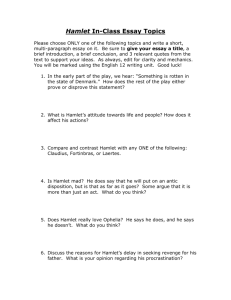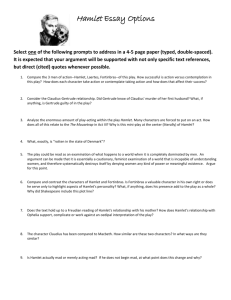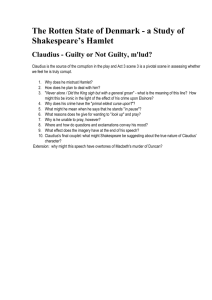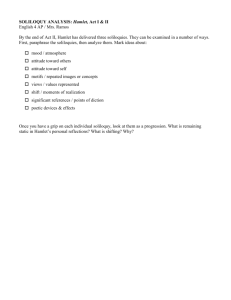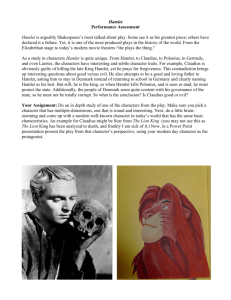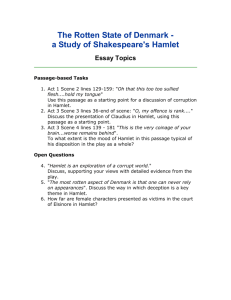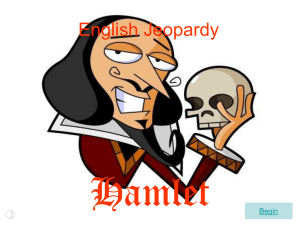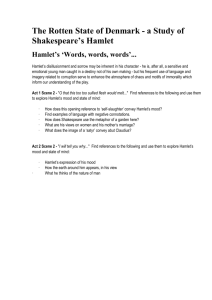Hamlet
advertisement
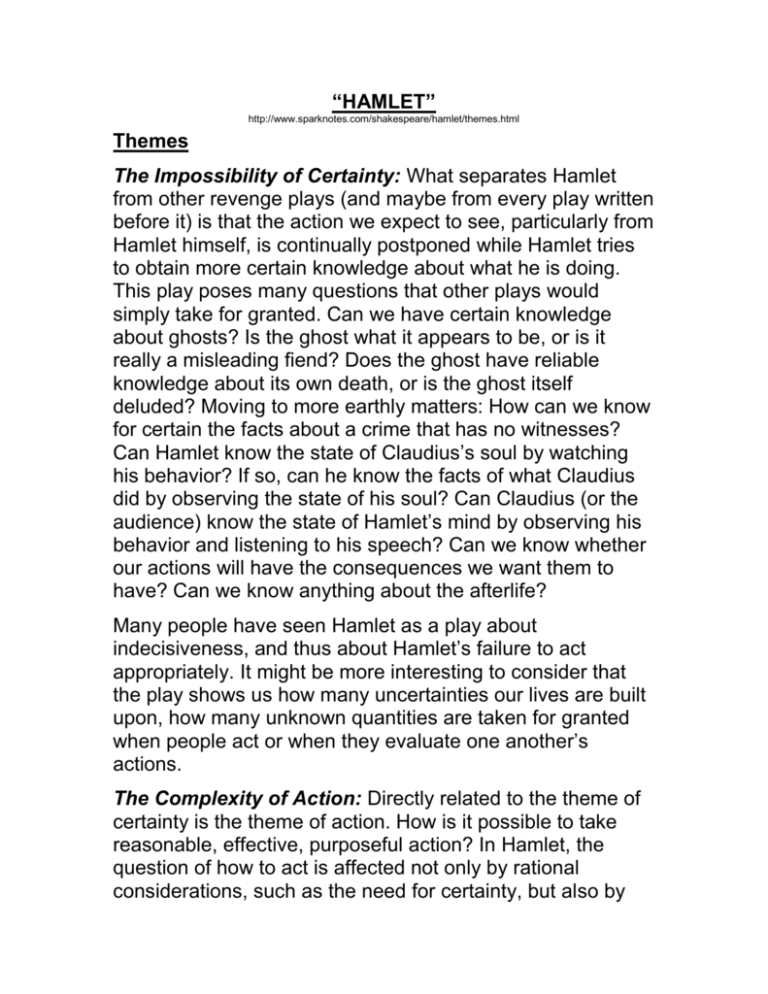
“HAMLET” http://www.sparknotes.com/shakespeare/hamlet/themes.html Themes The Impossibility of Certainty: What separates Hamlet from other revenge plays (and maybe from every play written before it) is that the action we expect to see, particularly from Hamlet himself, is continually postponed while Hamlet tries to obtain more certain knowledge about what he is doing. This play poses many questions that other plays would simply take for granted. Can we have certain knowledge about ghosts? Is the ghost what it appears to be, or is it really a misleading fiend? Does the ghost have reliable knowledge about its own death, or is the ghost itself deluded? Moving to more earthly matters: How can we know for certain the facts about a crime that has no witnesses? Can Hamlet know the state of Claudius’s soul by watching his behavior? If so, can he know the facts of what Claudius did by observing the state of his soul? Can Claudius (or the audience) know the state of Hamlet’s mind by observing his behavior and listening to his speech? Can we know whether our actions will have the consequences we want them to have? Can we know anything about the afterlife? Many people have seen Hamlet as a play about indecisiveness, and thus about Hamlet’s failure to act appropriately. It might be more interesting to consider that the play shows us how many uncertainties our lives are built upon, how many unknown quantities are taken for granted when people act or when they evaluate one another’s actions. The Complexity of Action: Directly related to the theme of certainty is the theme of action. How is it possible to take reasonable, effective, purposeful action? In Hamlet, the question of how to act is affected not only by rational considerations, such as the need for certainty, but also by emotional, ethical, and psychological factors. Hamlet himself appears to distrust the idea that it’s even possible to act in a controlled, purposeful way. When he does act, he prefers to do it blindly, recklessly, and violently. The other characters obviously think much less about “action” in the abstract than Hamlet does, and are therefore less troubled about the possibility of acting effectively. They simply act as they feel is appropriate. But in some sense they prove that Hamlet is right, because all of their actions miscarry. Claudius possesses himself of queen and crown through bold action, but his conscience torments him, and he is beset by threats to his authority (and, of course, he dies). Laertes resolves that nothing will distract him from acting out his revenge, but he is easily influenced and manipulated into serving Claudius’s ends, and his poisoned rapier is turned back upon himself. The Mystery of Death: In the aftermath of his father’s murder, Hamlet is obsessed with the idea of death, and over the course of the play he considers death from a great many perspectives. He ponders both the spiritual aftermath of death, embodied in the ghost, and the physical remainders of the dead, such as by Yorick’s skull and the decaying corpses in the cemetery. Throughout, the idea of death is closely tied to the themes of spirituality, truth, and uncertainty in that death may bring the answers to Hamlet’s deepest questions, ending once and for all the problem of trying to determine truth in an ambiguous world. And, since death is both the cause and the consequence of revenge, it is intimately tied to the theme of revenge and justice— Claudius’s murder of King Hamlet initiates Hamlet’s quest for revenge, and Claudius’s death is the end of that quest. The question of his own death plagues Hamlet as well, as he repeatedly contemplates whether or not suicide is a morally legitimate action in an unbearably painful world. Hamlet’s grief and misery is such that he frequently longs for death to end his suffering, but he fears that if he commits suicide, he will be consigned to eternal suffering in hell because of the Christian religion’s prohibition of suicide. In his famous “To be or not to be” soliloquy (III.i), Hamlet philosophically concludes that no one would choose to endure the pain of life if he or she were not afraid of what will come after death, and that it is this fear which causes complex moral considerations to interfere with the capacity for action. The Nation as a Diseased Body: Everything is connected in Hamlet, including the welfare of the royal family and the health of the state as a whole. The play’s early scenes explore the sense of anxiety and dread that surrounds the transfer of power from one ruler to the next. Throughout the play, characters draw explicit connections between the moral legitimacy of a ruler and the health of the nation. Denmark is frequently described as a physical body made ill by the moral corruption of Claudius and Gertrude, and many observers interpret the presence of the ghost as a supernatural omen indicating that “[s]omething is rotten in the state of Denmark” (I.iv.67). The dead King Hamlet is portrayed as a strong, forthright ruler under whose guard the state was in good health, while Claudius, a wicked politician, has corrupted and compromised Denmark to satisfy his own appetites. At the end of the play, the rise to power of the upright Fortinbras suggests that Denmark will be strengthened once again. Motifs Incest and Incestuous Desire: The motif of incest runs throughout the play and is frequently alluded to by Hamlet and the ghost, most obviously in conversations about Gertrude and Claudius, the former brother-in-law and sisterin-law who are now married. A subtle motif of incestuous desire can be found in the relationship of Laertes and Ophelia, as Laertes sometimes speaks to his sister in suggestively sexual terms and, at her funeral, leaps into her grave to hold her in his arms. However, the strongest overtones of incestuous desire arise in the relationship of Hamlet and Gertrude, in Hamlet’s fixation on Gertrude’s sex life with Claudius and his preoccupation with her in general. Misogyny: Shattered by his mother’s decision to marry Claudius so soon after her husband’s death, Hamlet becomes cynical about women in general, showing a particular obsession with what he perceives to be a connection between female sexuality and moral corruption. This motif of misogyny, or hatred of women, occurs sporadically throughout the play, but it is an important inhibiting factor in Hamlet’s relationships with Ophelia and Gertrude. He urges Ophelia to go to a nunnery rather than experience the corruptions of sexuality and exclaims of Gertrude, “Frailty, thy name is woman” (I.ii.146). Ears and Hearing: One facet of Hamlet’s exploration of the difficulty of attaining true knowledge is slipperiness of language. Words are used to communicate ideas, but they can also be used to distort the truth, manipulate other people, and serve as tools in corrupt quests for power. Claudius, the shrewd politician, is the most obvious example of a man who manipulates words to enhance his own power. The sinister uses of words are represented by images of ears and hearing, from Claudius’s murder of the king by pouring poison into his ear to Hamlet’s claim to Horatio that “I have words to speak in thine ear will make thee dumb” (IV.vi.21). The poison poured in the king’s ear by Claudius is used by the ghost to symbolize the corrosive effect of Claudius’s dishonesty on the health of Denmark. Declaring that the story that he was killed by a snake is a lie, he says that “the whole ear of Denmark” is “Rankly abused. . . .” (I.v.36–38). Symbols Yorick’s Skull: In Hamlet, physical objects are rarely used to represent thematic ideas. One important exception is Yorick’s skull, which Hamlet discovers in the graveyard in the first scene of Act V. As Hamlet speaks to the skull and about the skull of the king’s former jester, he fixates on death’s inevitability and the disintegration of the body. He urges the skull to “get you to my lady’s chamber, and tell her, let her paint an inch thick, to this favor she must come”—no one can avoid death (V.i.178–179). He traces the skull’s mouth and says, “Here hung those lips that I have kissed I know not how oft,” indicating his fascination with the physical consequences of death (V.i.174–175). This latter idea is an important motif throughout the play, as Hamlet frequently makes comments referring to every human body’s eventual decay, noting that Polonius will be eaten by worms, that even kings are eaten by worms, and that dust from the decayed body of Alexander the Great might be used to stop a hole in a beer barrel.
